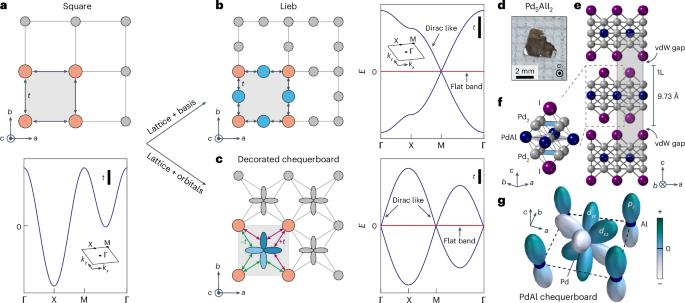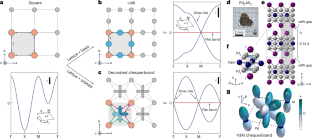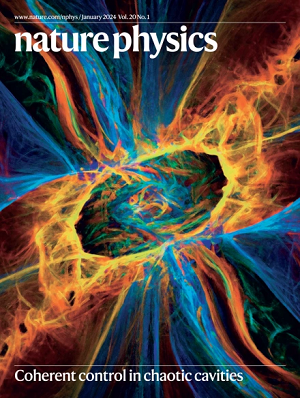Frustrated electron hopping from the orbital configuration in a two-dimensional lattice
IF 18.4
1区 物理与天体物理
Q1 PHYSICS, MULTIDISCIPLINARY
引用次数: 0
Abstract
Electron hopping on spatially periodic lattices gives rise to intriguing electronic behaviour. For example, hopping on the geometrically frustrated two-dimensional kagome, dice and Lieb lattices yields electronic band structures with both massless Dirac-like and perfectly dispersion-less, flat bands. As materials featuring the dice and Lieb lattice structures are scarce, an alternative approach proposes to leverage atomic orbitals to realize the characteristic electron hopping of geometrically frustrated lattices. This strategy promises to expand the list of candidate materials with frustrated electron hopping, but is yet to be shown in experiments. Here we demonstrate frustrated hopping in the van der Waals intermetallic Pd5AlI2, emerging from the arrangement of atomic orbitals in a primitive square lattice. Using angle-resolved photoemission spectroscopy and quantum oscillation measurements, we reveal that the band structure of Pd5AlI2 includes linear Dirac-like bands intersected at their crossing point by a locally flat band—an essential characteristic of frustrated hopping in Lieb and dice lattices. Moreover, this compound shows exceptional chemical stability, with its unusual bulk band structure and metallicity persisting in ambient conditions down to the monolayer limit. Hence, our results showcase a way to realize electronic structures characteristic of geometrically frustrated lattices in non-frustrated systems. Electron hopping in geometrically frustrated lattices can result in a rich variety of unusual behaviours. Now, the orbital arrangement in a van der Waals metal with a non-frustrated, primitive lattice is found to show similar effects.


二维晶格中受挫的电子从轨道构型中跳跃
在空间周期晶格上的电子跳跃产生了有趣的电子行为。例如,在几何上受挫的二维kagome、dice和Lieb晶格上跳跃,产生的电子能带结构既有无质量的类狄拉克结构,也有完全无色散的扁平能带。由于具有骰子和里布晶格结构的材料很少,因此提出了一种利用原子轨道来实现几何受挫晶格特征电子跳跃的替代方法。这一策略有望扩大具有受挫电子跳跃的候选材料的列表,但尚未在实验中得到证实。在这里,我们展示了范德华金属间化合物Pd5AlI2的受挫跳变,它出现在原始方形晶格中的原子轨道排列中。利用角分辨光发射光谱和量子振荡测量,我们发现Pd5AlI2的能带结构包括线性狄拉克类带,在它们的交叉点由局部平坦带相交,Äîan在Lieb和骰子晶格中受挫跳变的基本特征。此外,这种化合物表现出特殊的化学稳定性,其不寻常的体带结构和金属丰度在环境条件下一直保持到单层极限。因此,我们的研究结果展示了一种在非受挫系统中实现几何受挫晶格电子结构特征的方法。
本文章由计算机程序翻译,如有差异,请以英文原文为准。
求助全文
约1分钟内获得全文
求助全文
来源期刊

Nature Physics
物理-物理:综合
CiteScore
30.40
自引率
2.00%
发文量
349
审稿时长
4-8 weeks
期刊介绍:
Nature Physics is dedicated to publishing top-tier original research in physics with a fair and rigorous review process. It provides high visibility and access to a broad readership, maintaining high standards in copy editing and production, ensuring rapid publication, and maintaining independence from academic societies and other vested interests.
The journal presents two main research paper formats: Letters and Articles. Alongside primary research, Nature Physics serves as a central source for valuable information within the physics community through Review Articles, News & Views, Research Highlights covering crucial developments across the physics literature, Commentaries, Book Reviews, and Correspondence.
 求助内容:
求助内容: 应助结果提醒方式:
应助结果提醒方式:


